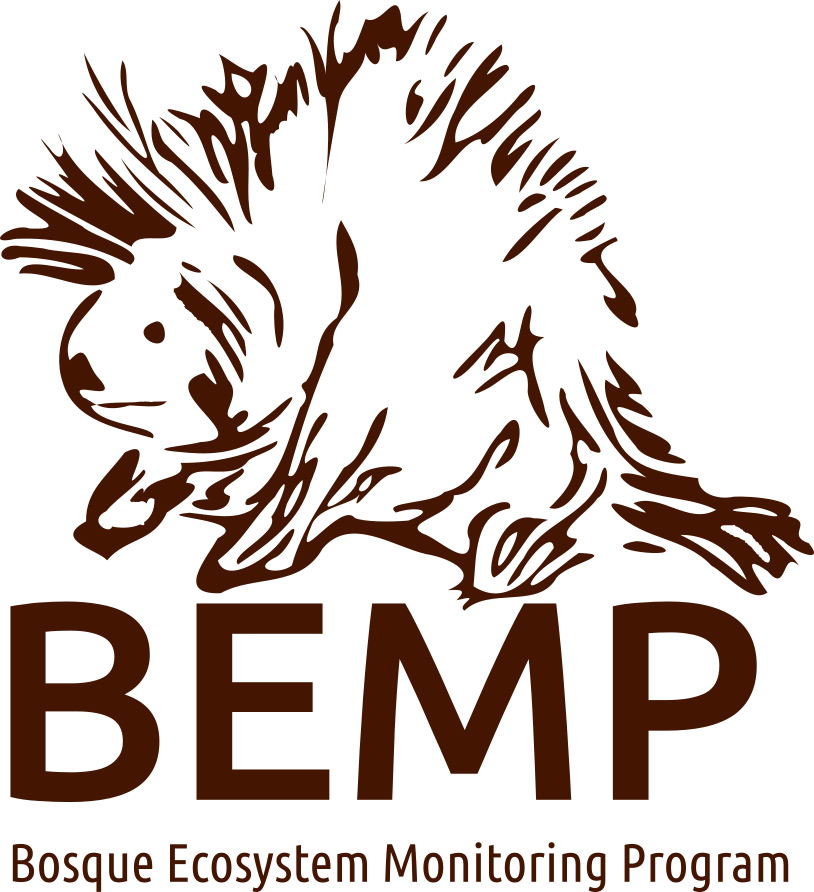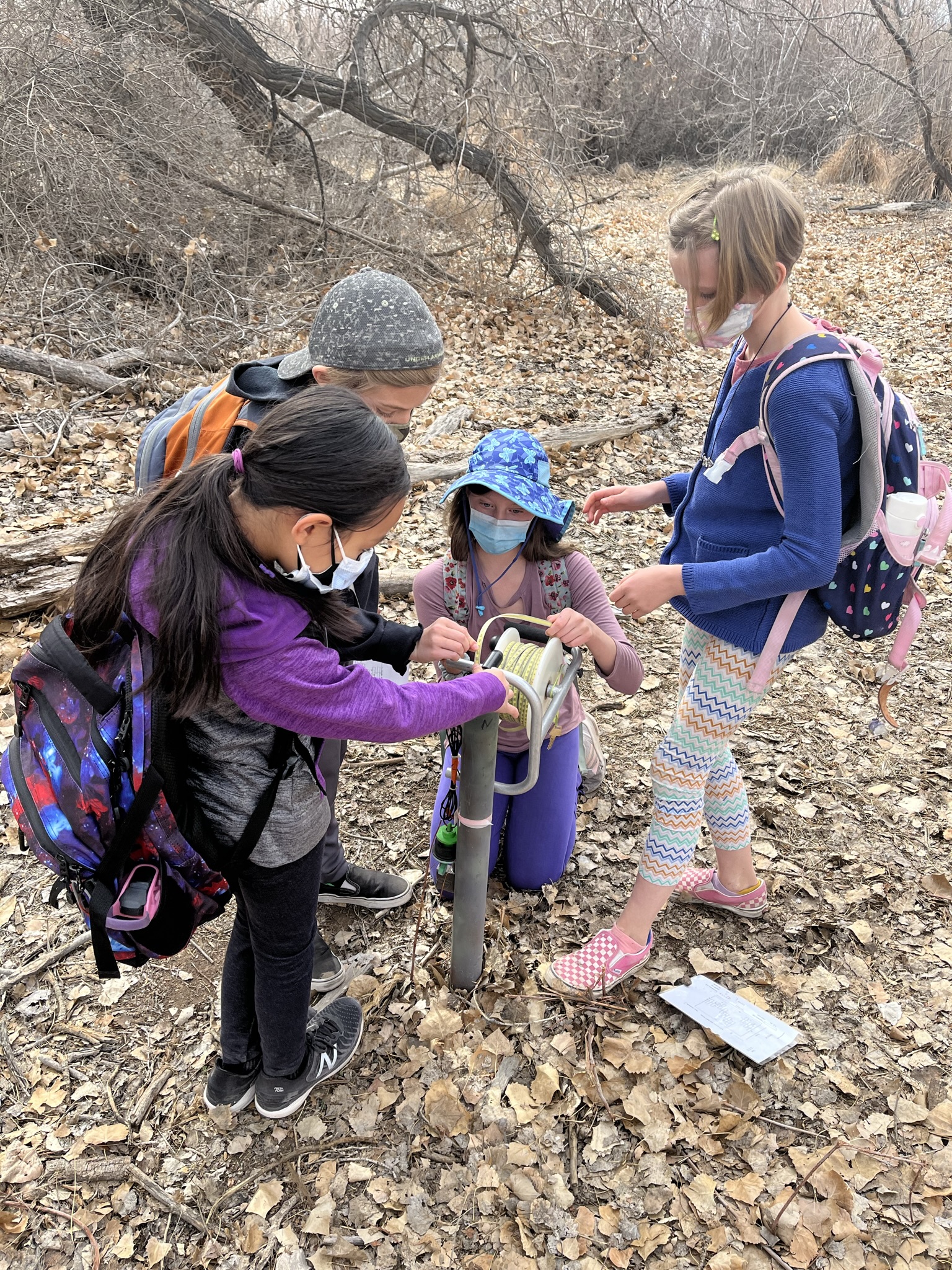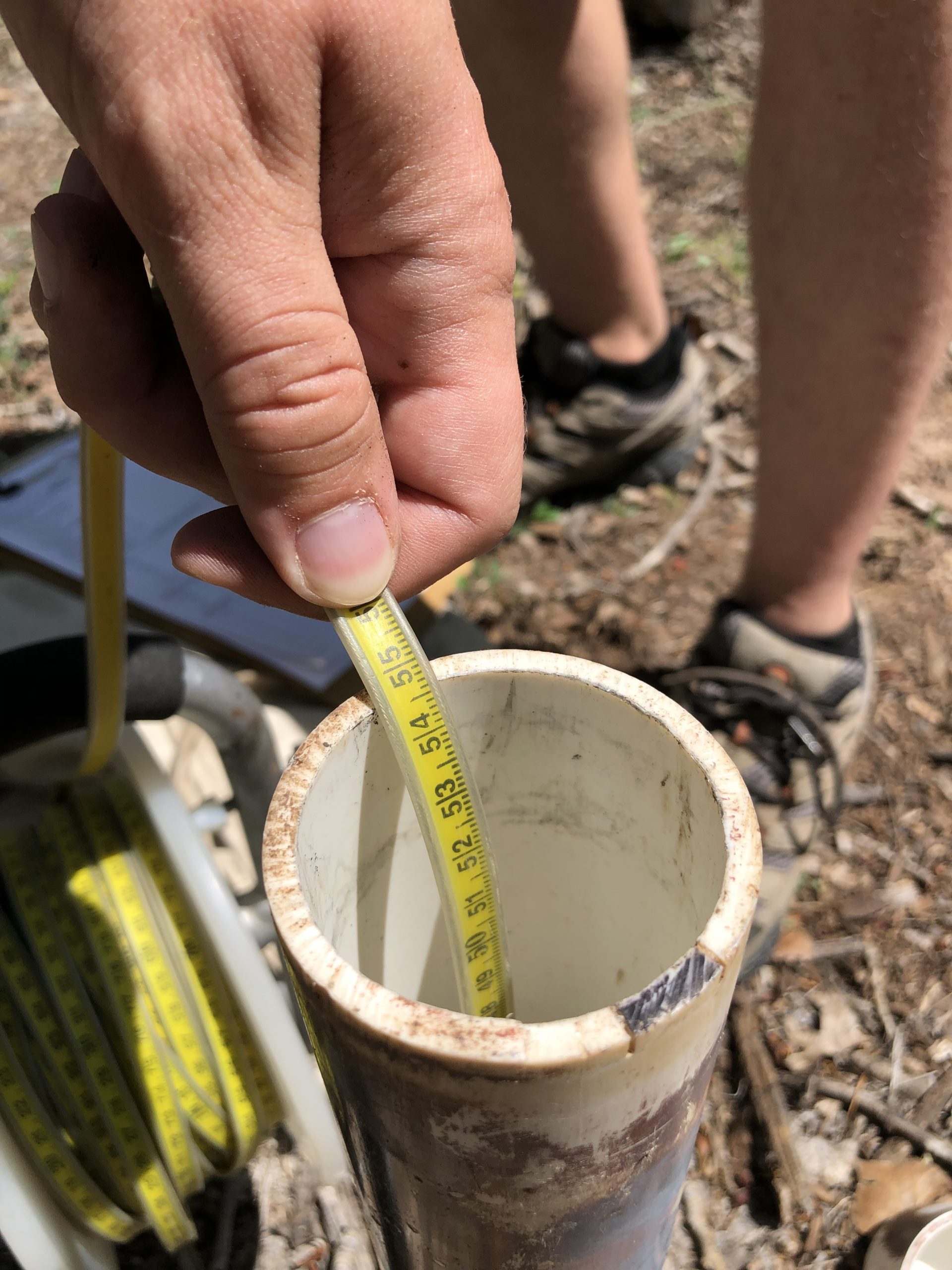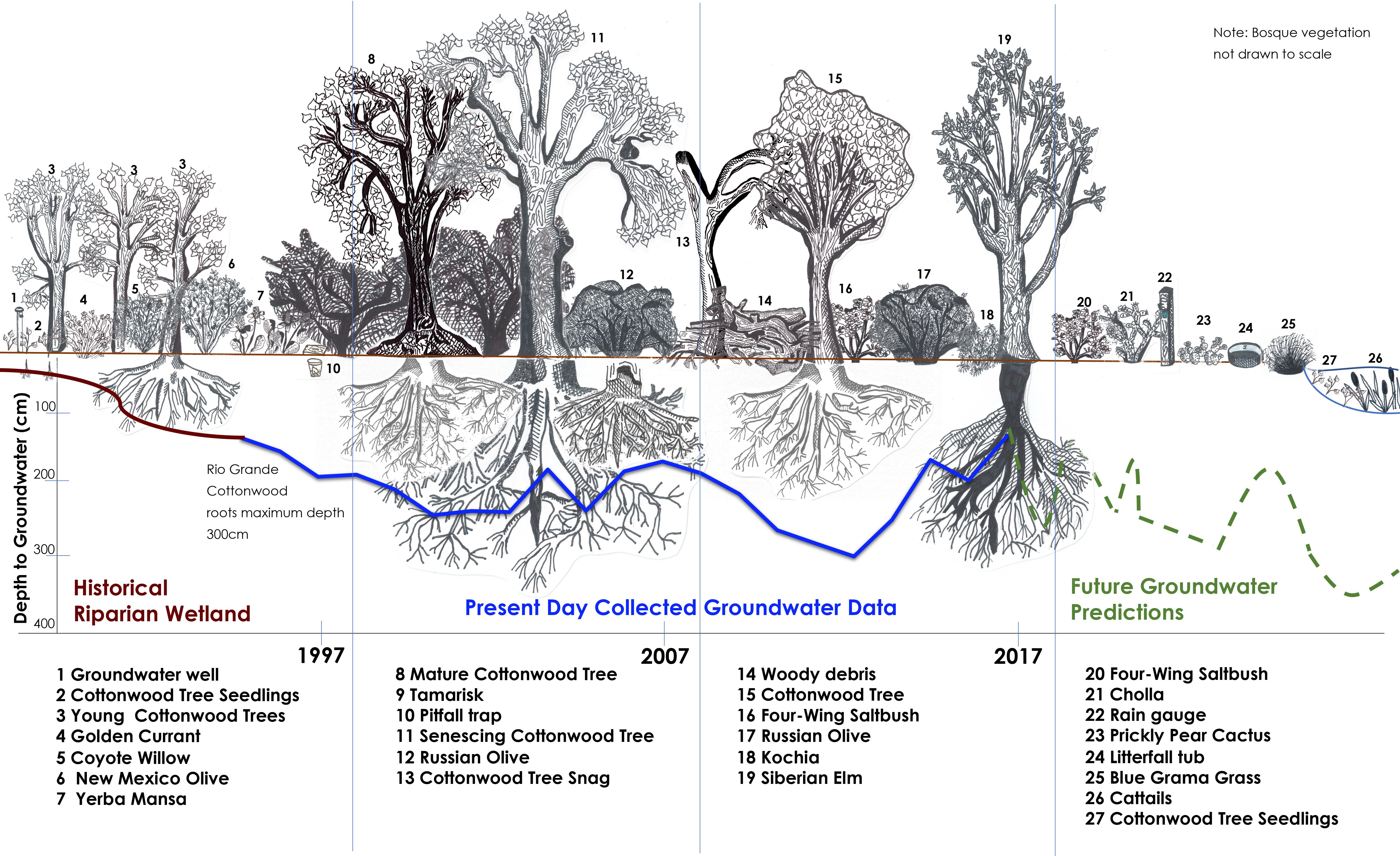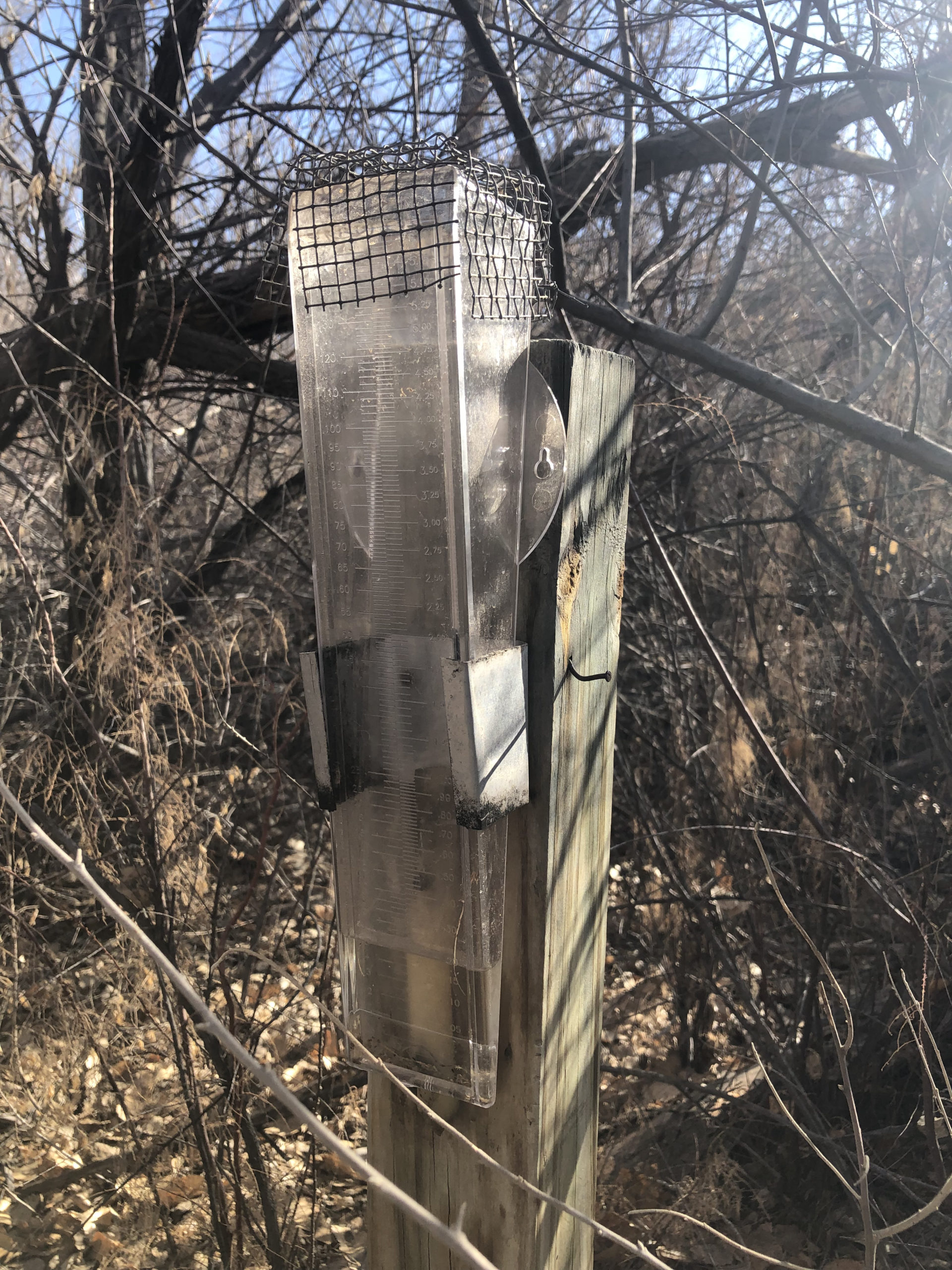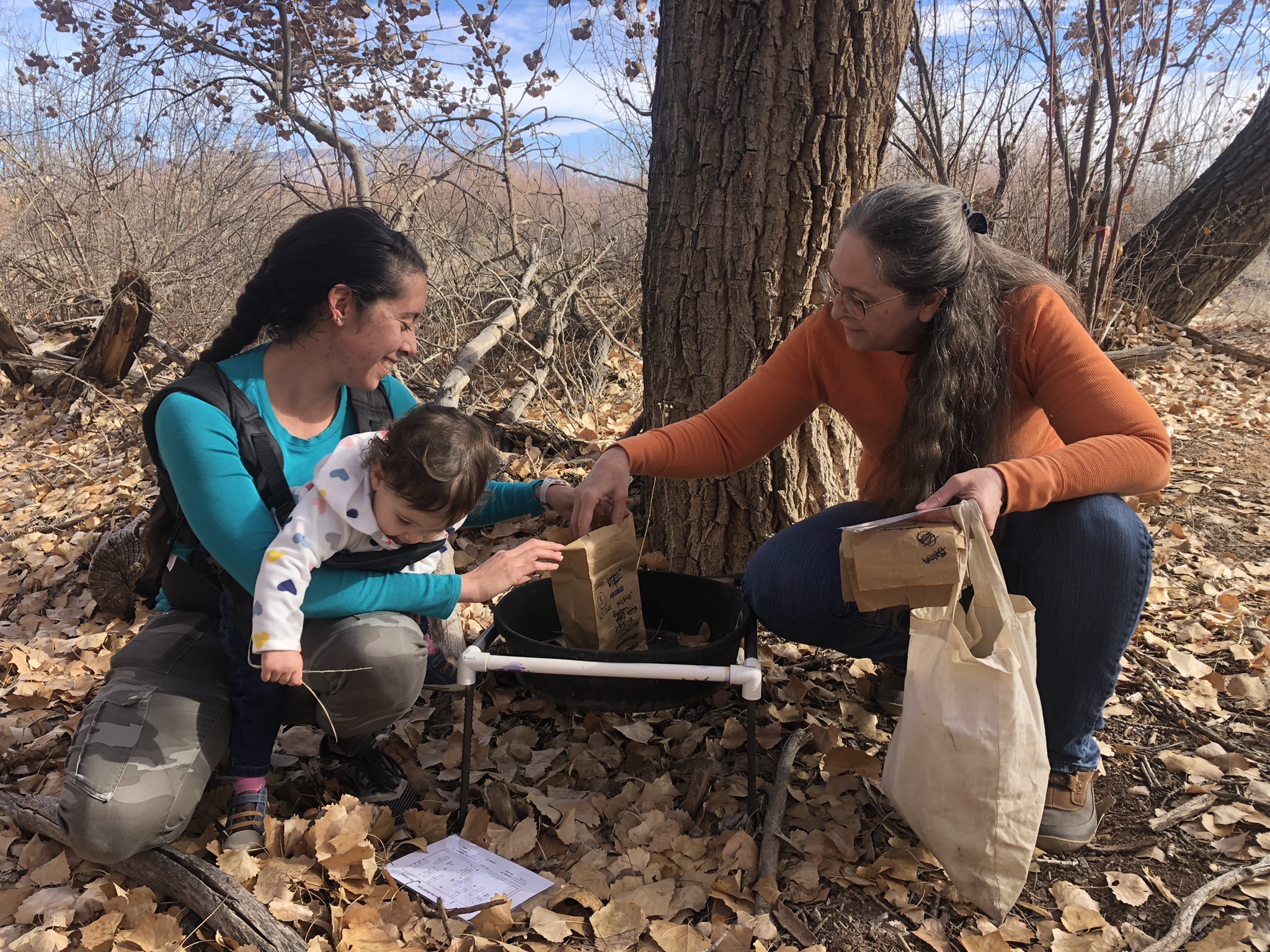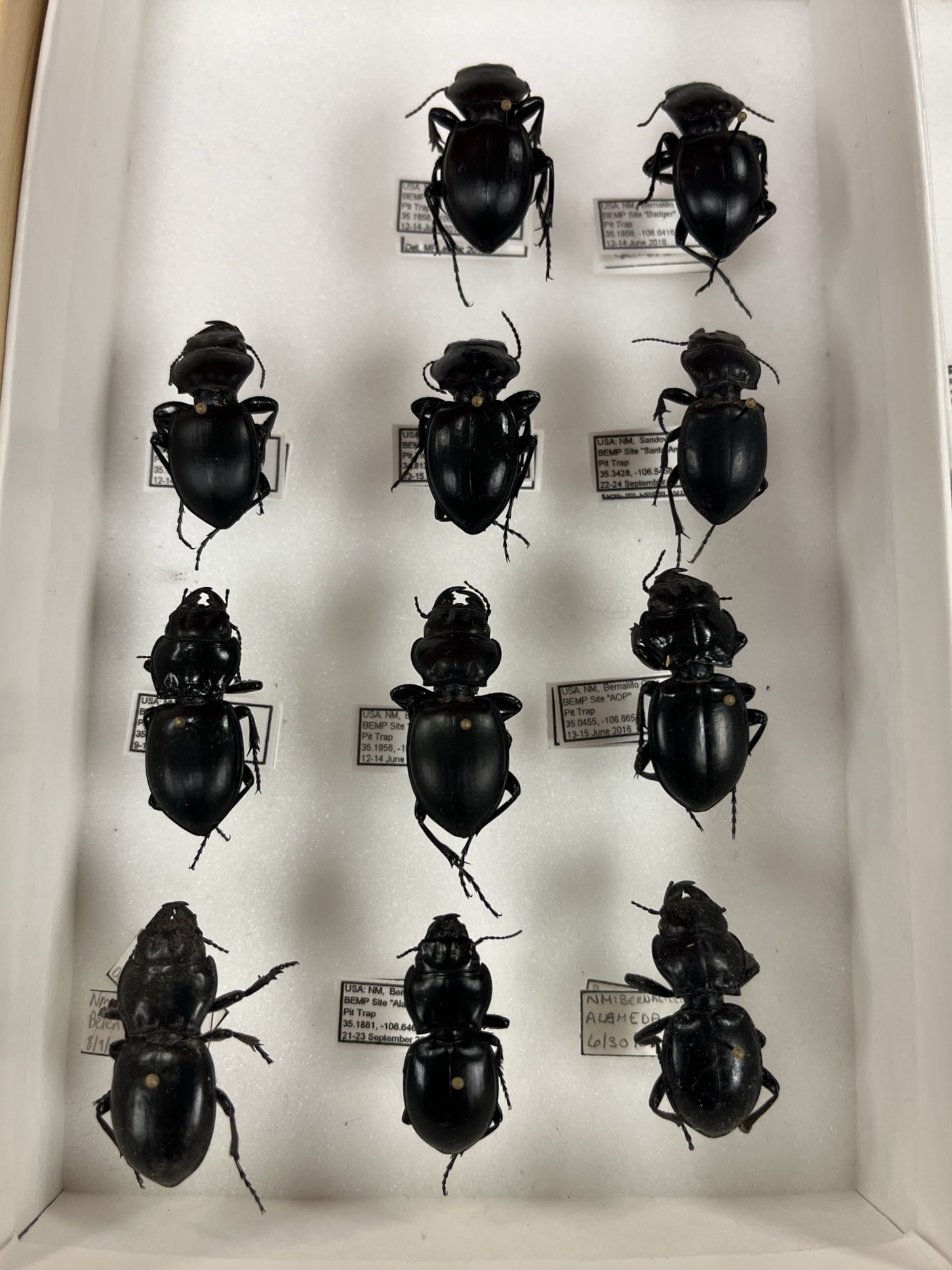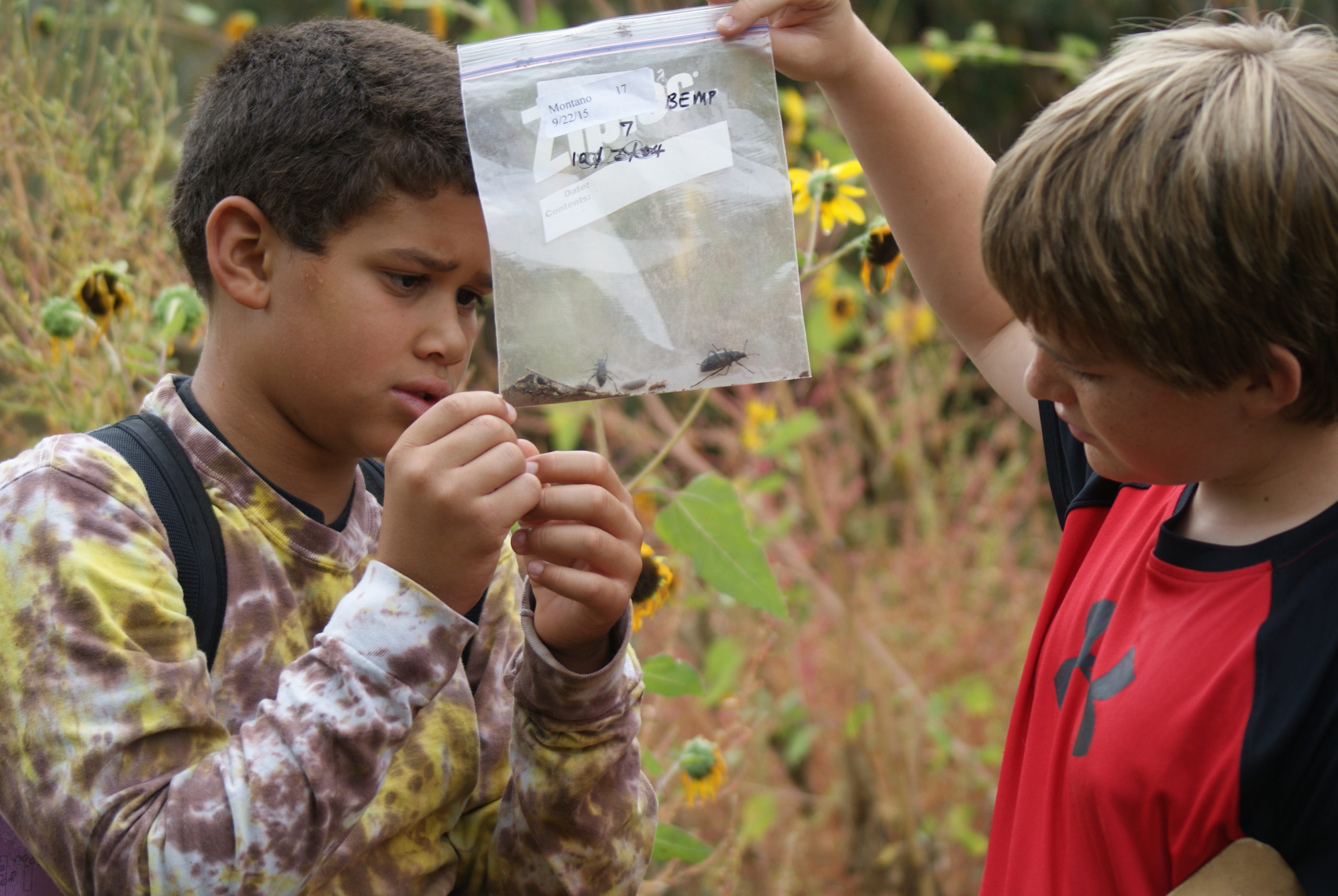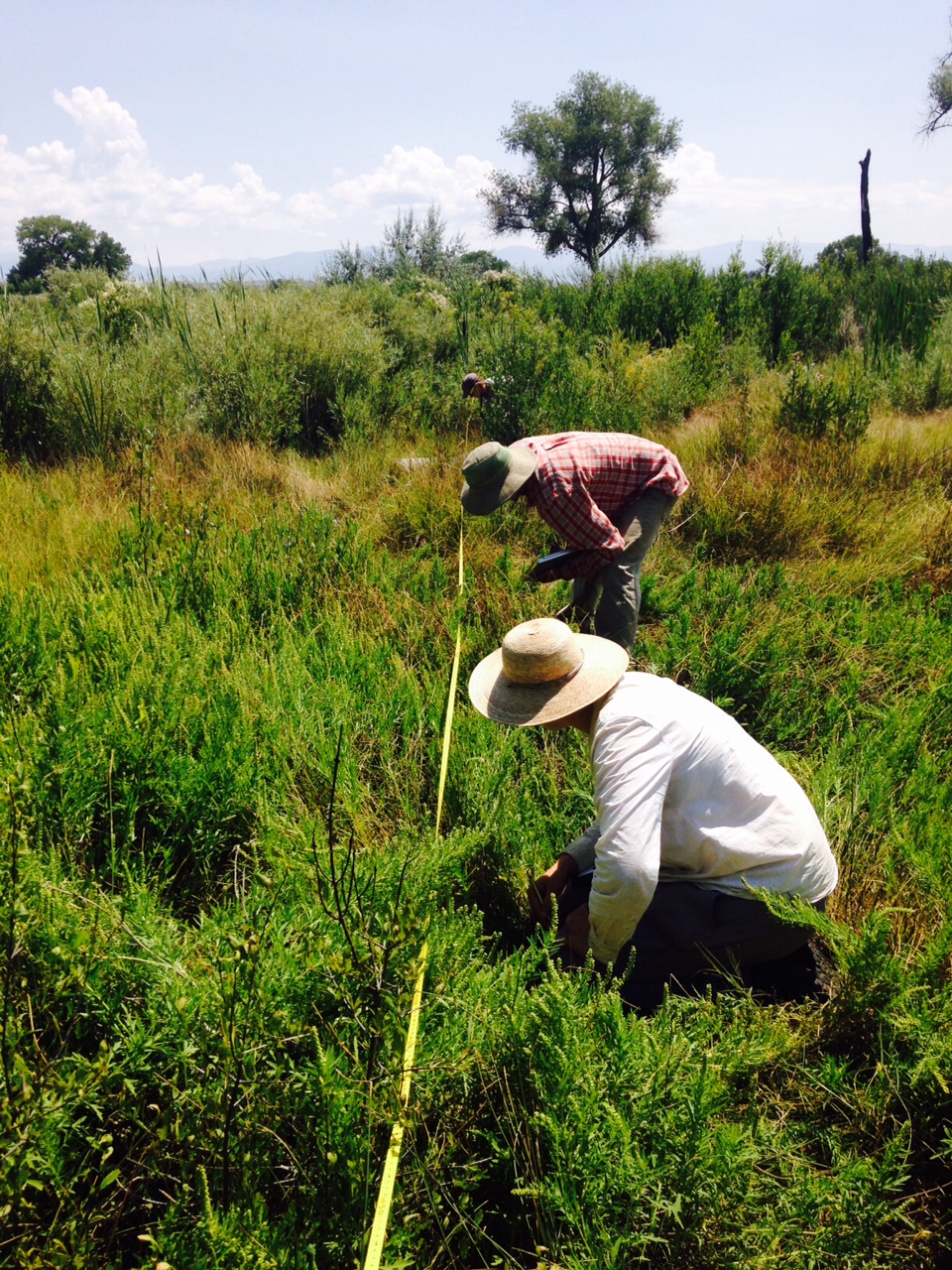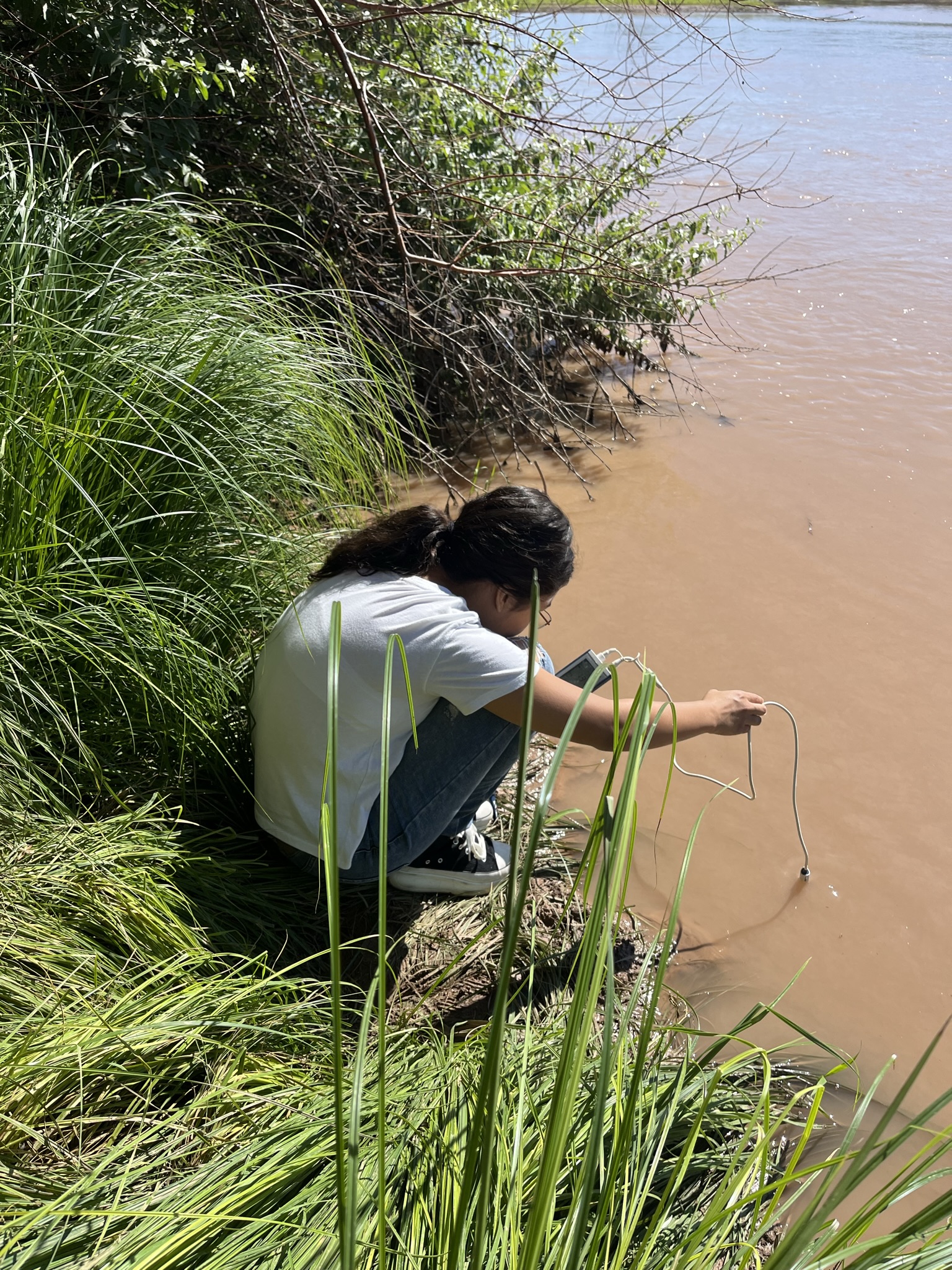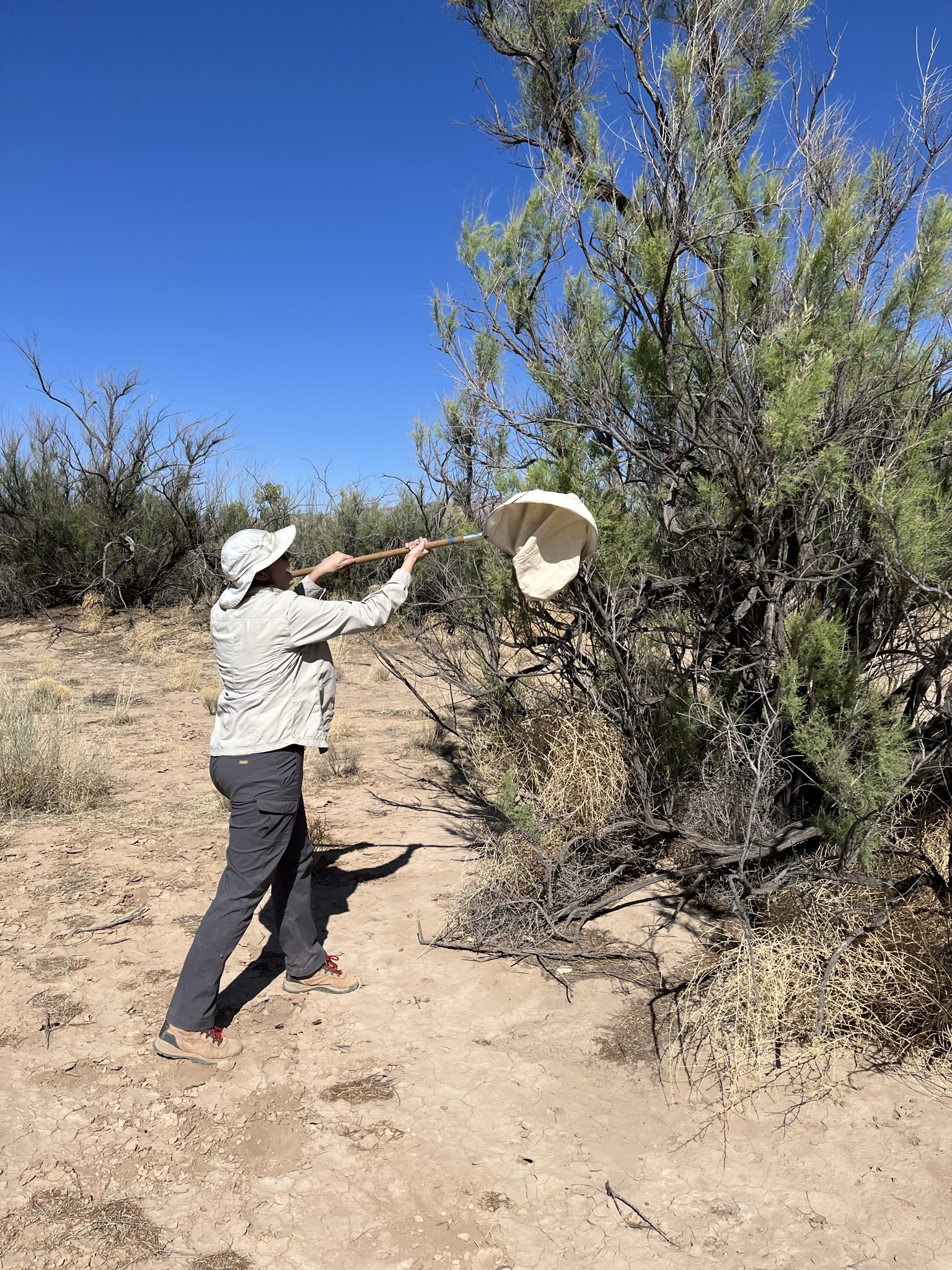Science
Based on 26 years of BEMP data, we see that flooding is the key ecological driver of the bosque.
BEMP data is publicly available by any interested user. To request current raw data, data analysis, and/or effects of land management strategies at various BEMP sites, please contact BEMP Data Manager, Ara Winter, PhD. at akooser@unm.edu
To see what datasets are available, look at our GitHub data page.
Our mission is to monitor biotic and abiotic dynamics in the Middle Rio Grande bosque ecosystem while meaningfully involving the community and educating students. We collect and analyze data at established sites across the Middle Rio Grande valley, maintaining several long-term core datasets, all with the participation of K-12 students, university interns, and community scientists. BEMP data document ecological and climatic processes in the bosque, inform research about overall ecosystem health, and shed light on impacts of ecological drivers like flooding, fire, climate, and human alteration. We do this by:
- Collecting comprehensive monthly monitoring data to best measure processes occurring in our unique bosque ecosystem.
- Involving students and community scientists of all ages and backgrounds in our data collection through diverse partnerships with schools and organizations.
- Ensuring quality of data; our scientific protocols are consistent with agency guidelines, and data are processed in conjunction with BEMP’s lead science partner, the University of New Mexico’s Department of Biology.
- Using data to answer important questions like “What are the effects of particular management decisions and actions?” and, “What are best management practices for bosque restoration?”
- Sharing BEMP findings with state, local, tribal, and federal resource managers, informing multi-million dollar bosque management decisions.
- Making our data publicly available and accessible to the community.
Additional Science Links
Citation for BEMP Data Sets:
BEMP Data. Date updated. BEMP Database: name of dataset. From Bosque Ecosystem Monitoring Program. BEMP, University of New Mexico, Albuquerque, NM. Online: https://bemp.org/data-sets/ Date Retrieved.
Example for groundwater data:
BEMP Data. 2015. BEMP Database: Depth to Groundwater 1997-2015. From Bosque Ecosystem Monitoring Program. BEMP, University of New Mexico, Albuquerque, NM. Online: https://bemp.org/data-sets/ Accessed on August 31, 2016.
Our Datasets
Groundwater is any water that has infiltrated the soil and collected underground. Plants use groundwater to survive and need to have enough water to grow. Native cottonwood trees, for example, have roots that can only reach about 3 meters (10 ft) deep. Many exotic tree species currently in the bosque have the ability to reach water further down with their longer, faster-growing taproots. We (humans!) also use this water for drinking and to grow food.
BEMP sites are equipped with five groundwater wells arranged on a grid (each site has a Center, North, South, East, and West well). Every month BEMP staff, interns, volunteers, and students go out into the bosque and check how deep below the ground the water level is at each of these wells. We collect groundwater data using a water level meter called a beeper. This instrument consists of a measuring tape with a water probe at the end of it. We lower the tape, probe end first, into the well until it reaches the water underground and makes a beeping sound.
The depth to groundwater measurement (how far down to reach water) is an important indicator of vegetation health and helps us better understand the water cycle and evapotranspiration dynamics of the bosque ecosystem. Thus, by monitoring groundwater, we can learn more about the health of our bosque, the Rio Grande, and all the ecosystems we call home.
Educational Resource Links
- BEMP Groundwater Monitoring Activity:
- BEMP Dabbling in Data:
Box plots of mean monthly depth to groundwater for all BEMP sites (1997-2022). The teal continuous line represents the typical threshold for root depth of cottonwood trees (Populus deltoides). The blue lines above each year represent the median depth to groundwater.
Precipitation is any water that falls from the sky. It can be in the form of rain, hail, snow, and more. Here in the desert, precipitation is scarce. Typically, Albuquerque gets a total of 20 inches of precipitation per year. Collecting precipitation data can help us make predictions about arthropod activity, phenological changes in plants and animals, and water availability for humans and plants.
To gather these data, we use Tru-Chek Rain Gauges to measure precipitation in millimeters and inches. To prevent evaporation, a small amount of vegetable oil is added to each gauge. Oil is less dense than water, so it sits on top creating a seal, allowing us to capture an accurate reading. Every month, BEMP staff, students, and volunteers visit our research sites, record the amount of precipitation collected, and reset the gauges by emptying them and adding oil.
There are two gauges at each of our sites; one under trees (the canopy rain gauge) and another out in a clear area (the open rain gauge). This placement of gauges helps us understand how the bosque canopy might affect the distribution of precipitation that’s reaching the ground across the landscape. In some instances the canopy can act as a funnel and direct water into an area, while in other cases it might act as a shield moving water away. Different sites have different reactions to the trees!
Educational Resource Links
-
- Precipitation station YouTube Video.
- Precipitation station activity handout:

Monthly precipitation at Los Lunas BEMP site. Dot size indicates the amount of precipitation from January 2000 to December 2020. These data represent information collected from the open precipitation gauge and is presented in millimeters.
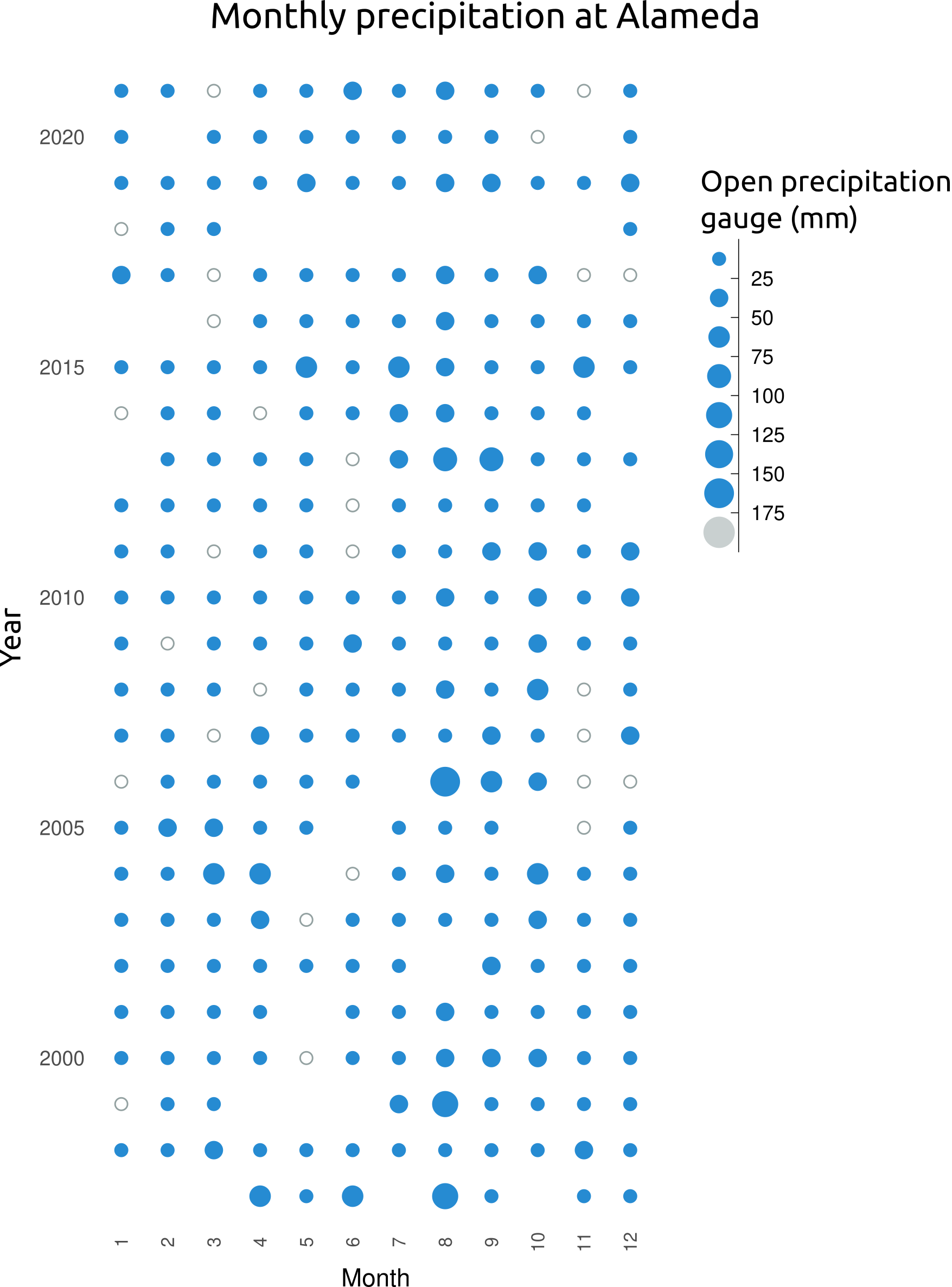
Monthly precipitation at Alameda BEMP site. Dot size indicates the amount of precipitation from January 2000 to December 2020. These data represent information collected from the open precipitation gauge and is presented in millimeters.
Litterfall is any plant material that falls onto the ground. This includes sticks, leaves, flowers, seeds, and any other plant parts. If a plant is still rooted in the ground, it is not litterfall. For example, a dead sunflower from last year that’s still rooted to the ground is not litterfall. Other things that are not litterfall that we sometimes find in our tubs include animal scat, human trash, and arthropods.
To collect litterfall data, we set out ten rubber tubs at each site. Once a month BEMP staff, interns, volunteers, and students gather the contents of these tubs, which are then processed by BEMP staff and interns at our University of New Mexico (UNM) lab. At UNM, we dry the litterfall to get rid of any water weight. We do this so we can have accurate comparisons of the weight of plant matter across species and over time. Once the litter is dry we take the total weight of everything found in a tub, sort it by plant species, weigh contents once again by species, and then enter what we found into our database.
Litterfall data can give us a lot of information about an ecosystem. We can see which plants are present, how abundant they are, and what they're doing each month. For example, we can see if invasive species like Russian Olive are increasing or decreasing in abundance. We can also determine what time of year Russian Olive trees are dropping seeds or dying off for the winter. Overtime we can identify if Russian Olives are releasing seeds earlier or later in the season. We can then compare this to patterns in other exotic species or native species in the bosque. All of this litterfall information can help land managers control invasive species, conserve native species, help us gauge the health of the ecosystem, and understand shifts across time and space.
Educational Resource Links
- BEMP Backyard Monitoring:
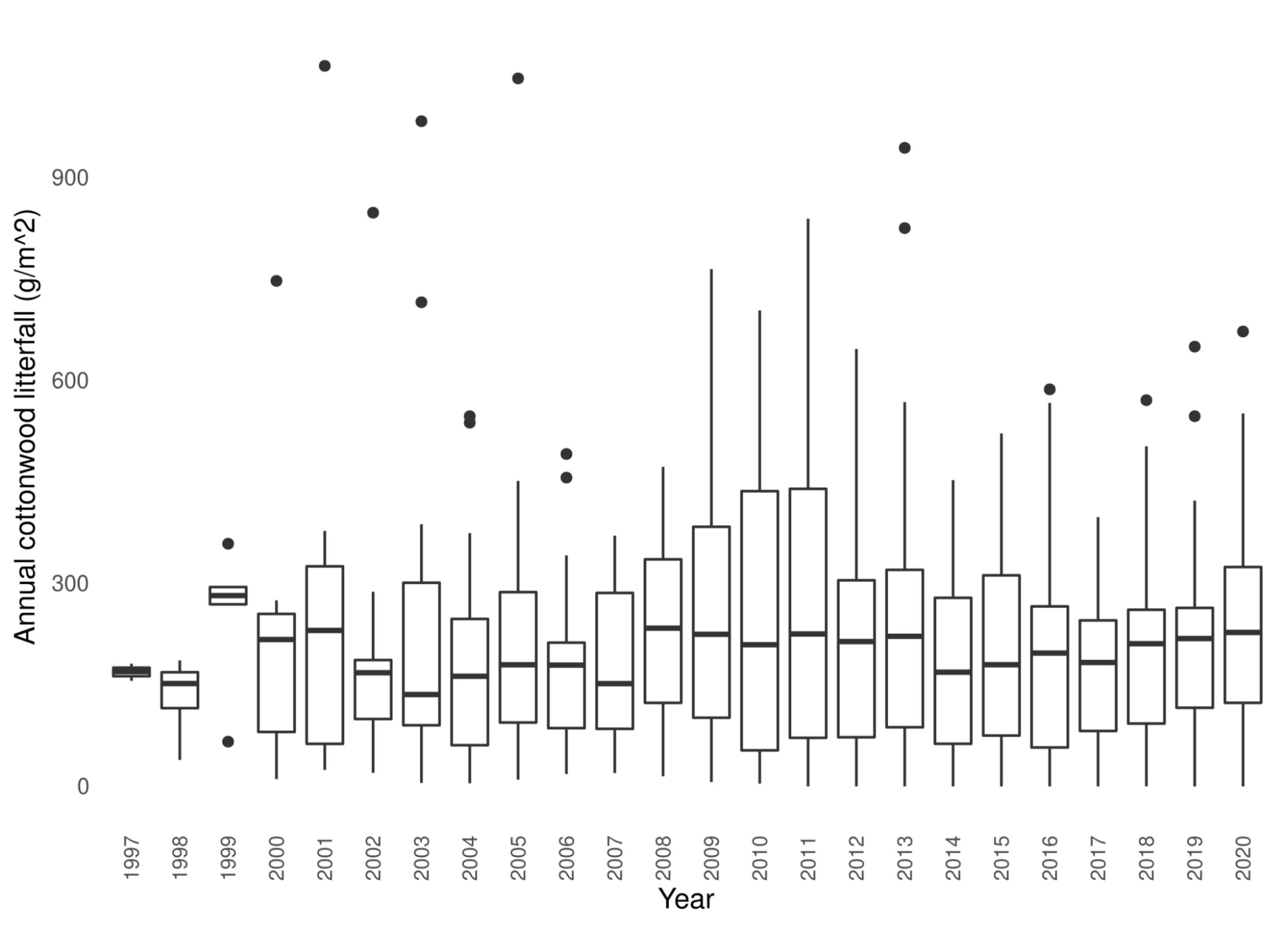
Cumulative annual cottonwood litterfall (g/m^2) from all study sites from 1997 to 2020. For each year median litterfall (horizontal black line), minimum and maximum litterfall (bottom/top end of each vertical line), and outliers (black dots) from monthly litter collections are shown.

Cumulative annual Russian olive (Elaeagnus angustifolia) litterfall (g/m^2) from all study sites from 1997 to 2020. For each year median litterfall (horizontal black line), minimum and maximum litterfall (bottom/top end of each vertical line), and outliers (black dots) from monthly litter collections are shown.
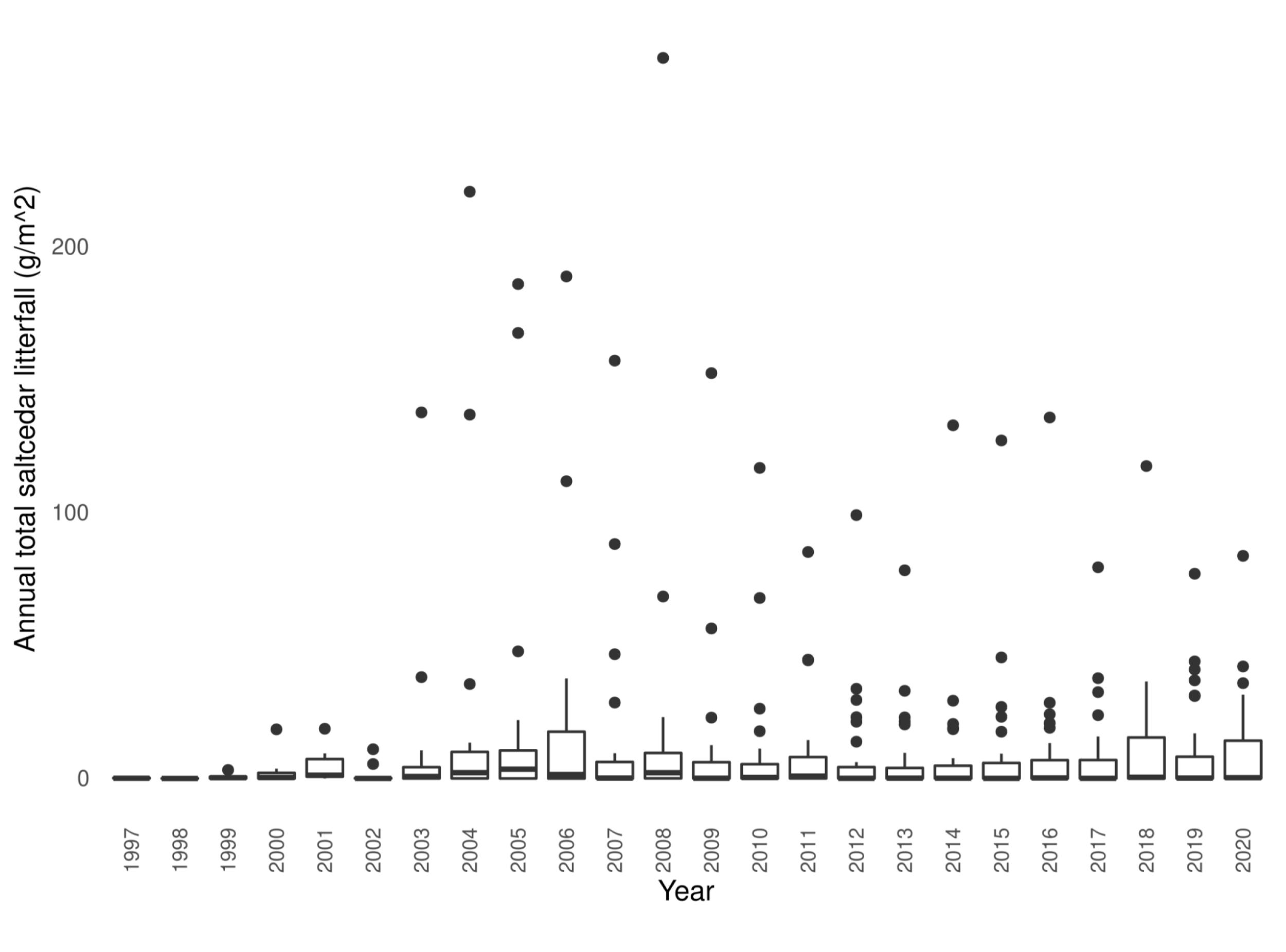
Cumulative annual salt cedar (Tamarix spp.) litterfall (g/m^2) from all study sites from 1997 to 2020. For each year median litterfall (horizontal black line), minimum and maximum litterfall (bottom/top end of each vertical line), and outliers (black dots) from monthly litter collections are shown.
An arthropod is an animal that has an exoskeleton, jointed legs, and a segmented body. Arthropods are key indicators of the health of an ecosystem. Many arthropods can be closely tied to specific environmental conditions. For instance, one beetle might thrive exclusively with high humidity and ample vegetation cover, while another may be found only in dry, sandy areas. Because of these preferences, BEMP can look at arthropod diversity and abundance in the bosque and use it to determine the types of habitats present in the bosque. This can help us understand what habitats are present where, how the ecosystem might be shifting over time, how sites are responding to anthropogenic change, and ultimately informs us about the overall health of the bosque.
BEMP collects arthropod data by using surface active arthropod pitfall traps. These pitfall traps are small cups flush with the ground that cannot be seen by arthropods walking on the ground. An unsuspecting arthropod will fall into these traps and, because of the smooth sides of the cup, cannot climb out. To collect, traps are opened 48 hours and then closed the remainder of the year. We collect arthropod pitfall traps three times a year; in May, July, and September, to gather insight into arthropod communities across the seasons. Not many arthropods are active when it’s really cold, so we do not perform collections in the winter.
Educational Resource Links
- Arthropod pitfall trapping activity:
- Arthropod pitfall trapping YouTube Video.
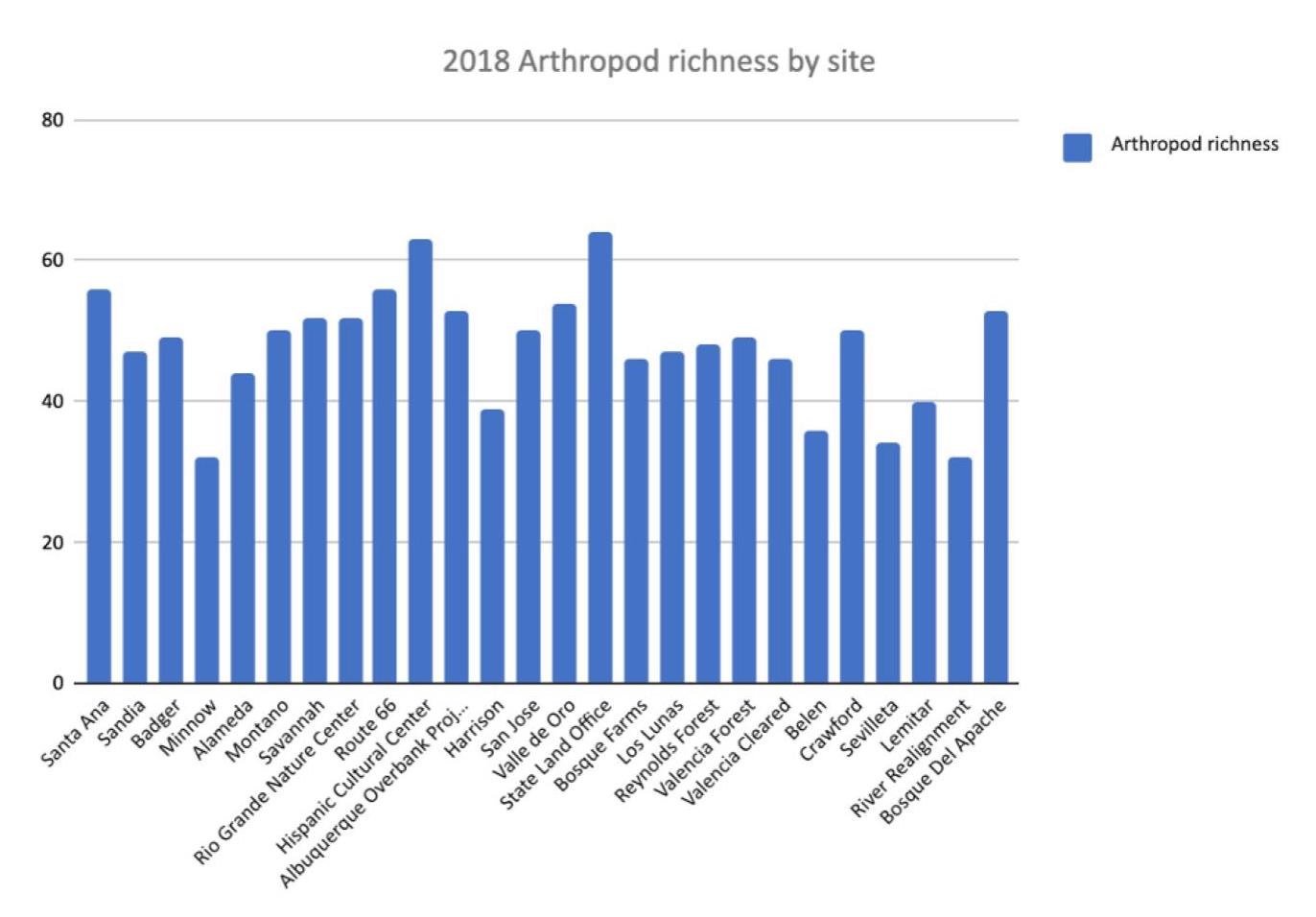 Arthropod richness by site in 2018. Arthropod richness (number of arthropod species collected) are represented in this graph for each BEMP site. The highest richness was found in southern Albuquerque at the State Land Office site.
Arthropod richness by site in 2018. Arthropod richness (number of arthropod species collected) are represented in this graph for each BEMP site. The highest richness was found in southern Albuquerque at the State Land Office site.
Arthropod abundance in 2018. Isopod (pill/sow bug) abundance, shown in blue, compared to all arthropod abundance, shown in orange, in 2018 at each BEMP site. Abundance describes the total number of arthropods collected at a site throughout the year. Isopods are useful bioindicators and highly correlated with moisture in an ecosystem, so we pay special attention to them in our analyses.
We survey vegetation at our sites once a year, working through all of our active sites in the months of August and September, during the peak of the growing season. We monitor vegetation cover (the portion of the ground that is covered by living plant material) as well as composition (the different plant species present that are making up this cover).
These data are collected by a crew of professional botanists in collaboration with BEMP staff. At each site, we monitor vegetation across ten 30-meter transects. A measuring tape is laid out across each transect. The crew then monitors the span of the tape, following it from beginning to end while measuring and identifying each plant intersecting the transect along the way, including the tree canopy overhead. The data are then reviewed for quality control and entered into our database.
Monitoring vegetation cover and composition gives us powerful insight into the plant communities present in the bosque. We can use these data to understand key elements of the ecosystem, such as species diversity, presence/abundance of native and exotic species, and changes over time as a response to climatic shifts or land use change. Plant cover plays important roles in ground moisture retention, erosion, and provides habitat for other organisms to thrive. Plant community shifts are important indicators of change in ecosystem health.
Educational Resource Links
- Bosque Plants:
- Seed Adaptations:
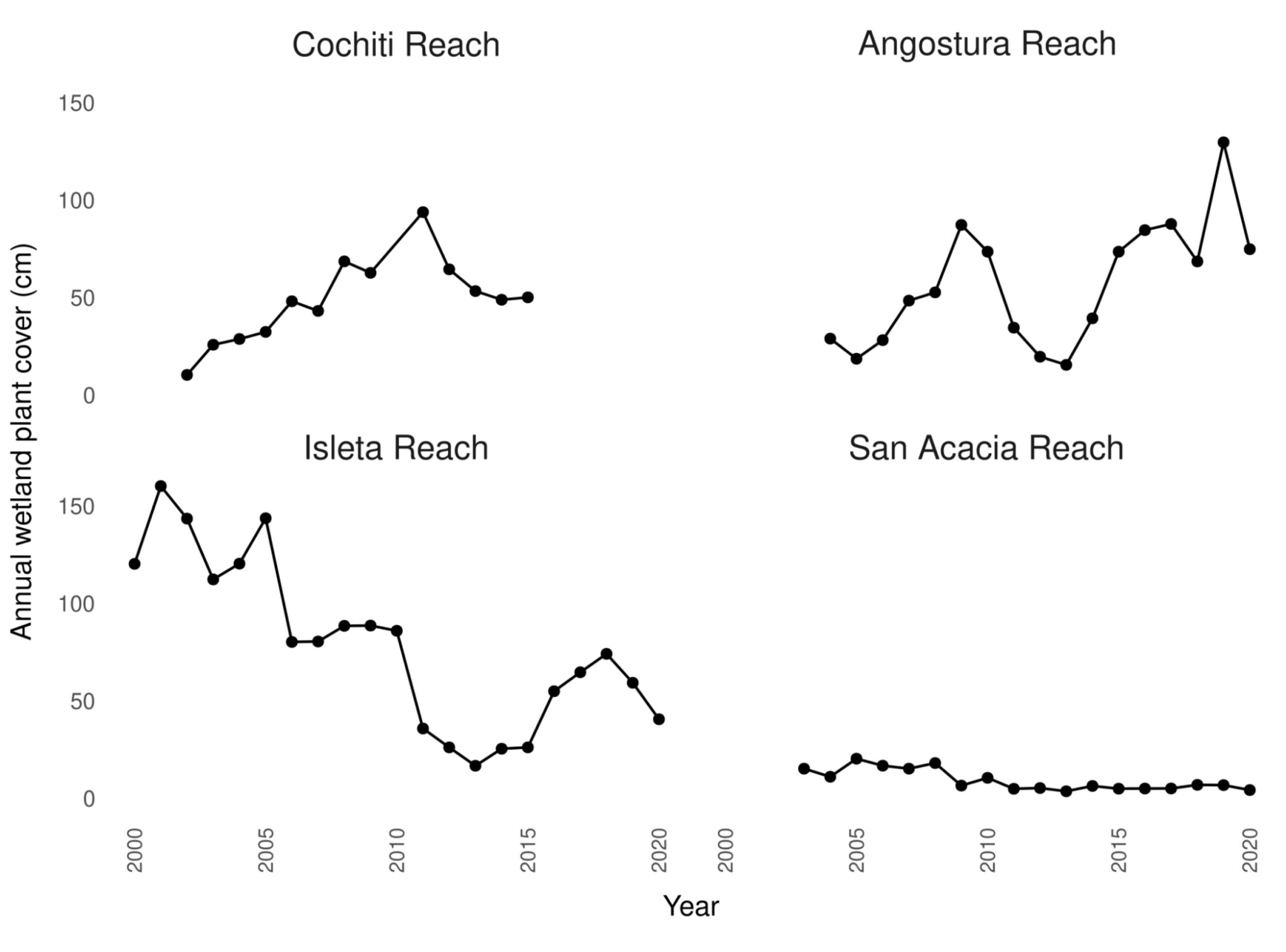 Wetland species vegetation cover on regularly surveyed transects at all BEMP sites from 2000-2020. Sites are grouped into stretches of the river, or reaches (from North to South: Cochiti, Angostura, Isleta, San Acacia).
Wetland species vegetation cover on regularly surveyed transects at all BEMP sites from 2000-2020. Sites are grouped into stretches of the river, or reaches (from North to South: Cochiti, Angostura, Isleta, San Acacia).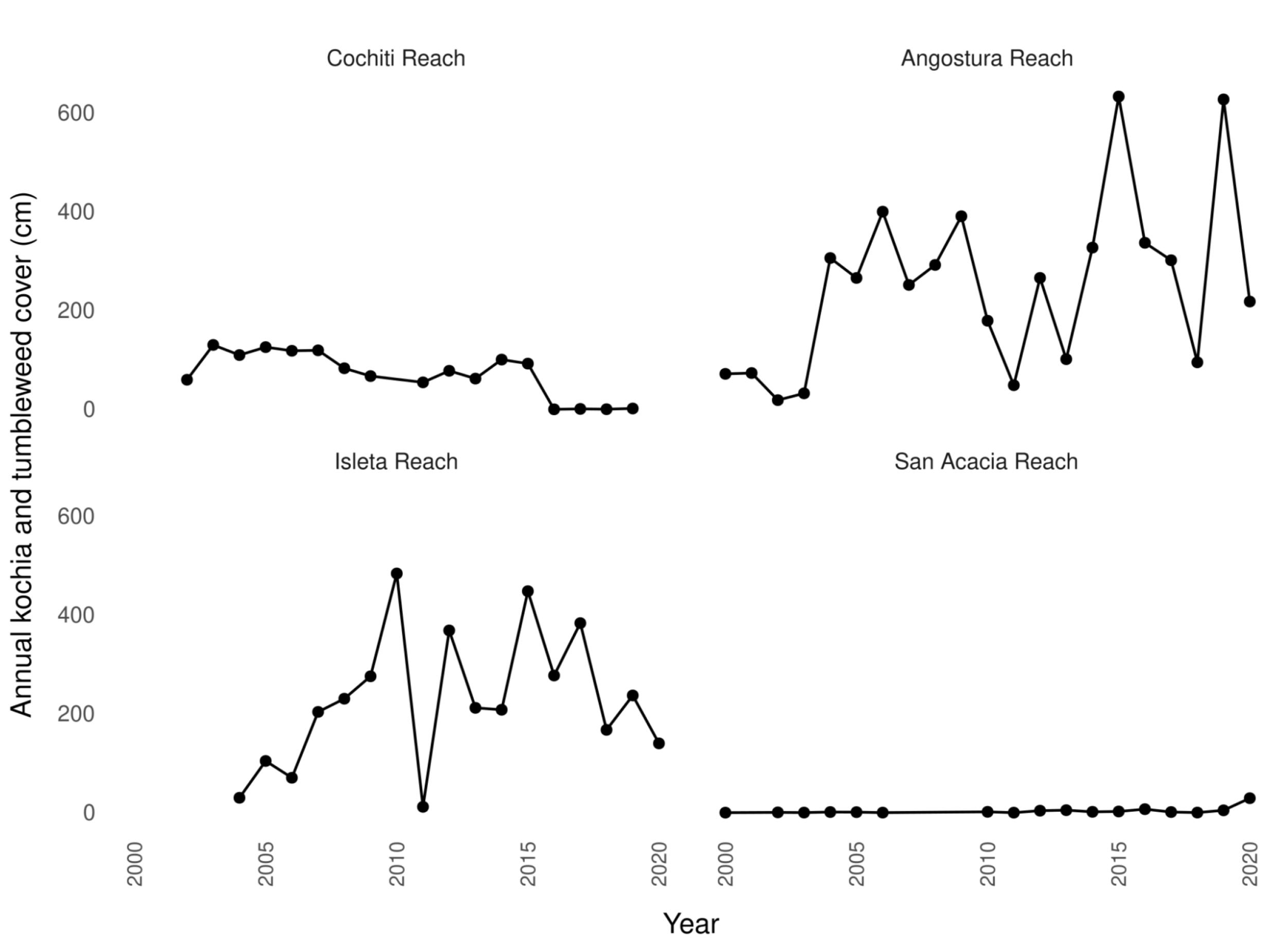 Exotic tumbleweed and kochia cover on regularly surveyed transects at all BEMP sites from 2000-2020. Sites are grouped into stretches of the river, or reaches (from North to South: Cochiti, Angostura, Isleta, San Acacia).
Exotic tumbleweed and kochia cover on regularly surveyed transects at all BEMP sites from 2000-2020. Sites are grouped into stretches of the river, or reaches (from North to South: Cochiti, Angostura, Isleta, San Acacia).The Rio Grande flows through Albuquerque, New Mexico and supports a diverse community of constituents who use it for recreation, agriculture, and drinking purposes. Regardless of how water is being used, it eventually makes it back to the Rio Grande through irrigation ditches and stormwater runoff. By monitoring the quality of the water in the river, we are able to gauge how healthy it is for both human use and for the bosque ecosystem as a whole. For example, this primary contact stream has exceeded Environmental Protection Agency (EPA) limitations for Escherichia coli (E.coli) bacteria and has been a cause for concern. The presence of this bacteria in high concentrations can cause human health issues and can also indicate the presence of other harmful pathogens.
Our work testing water quality is funded by The Middle Rio Grande Stormwater Quality Team to monitor the Albuquerque Reach of the Rio Grande for bacterial pathogens, like E.Coli, and other field parameters including dissolved oxygen (DO), specific conductance, conductivity, pH, turbidity, and water temperature.
BEMP also engages student and community scientists to learn the importance of water chemistry composition, and how the river responds to different additions of citywide water, like stormwater runoff. Collectively, this information is utilized by natural resource managers to help ensure national water quality standards are being met.
Educational Resource Links
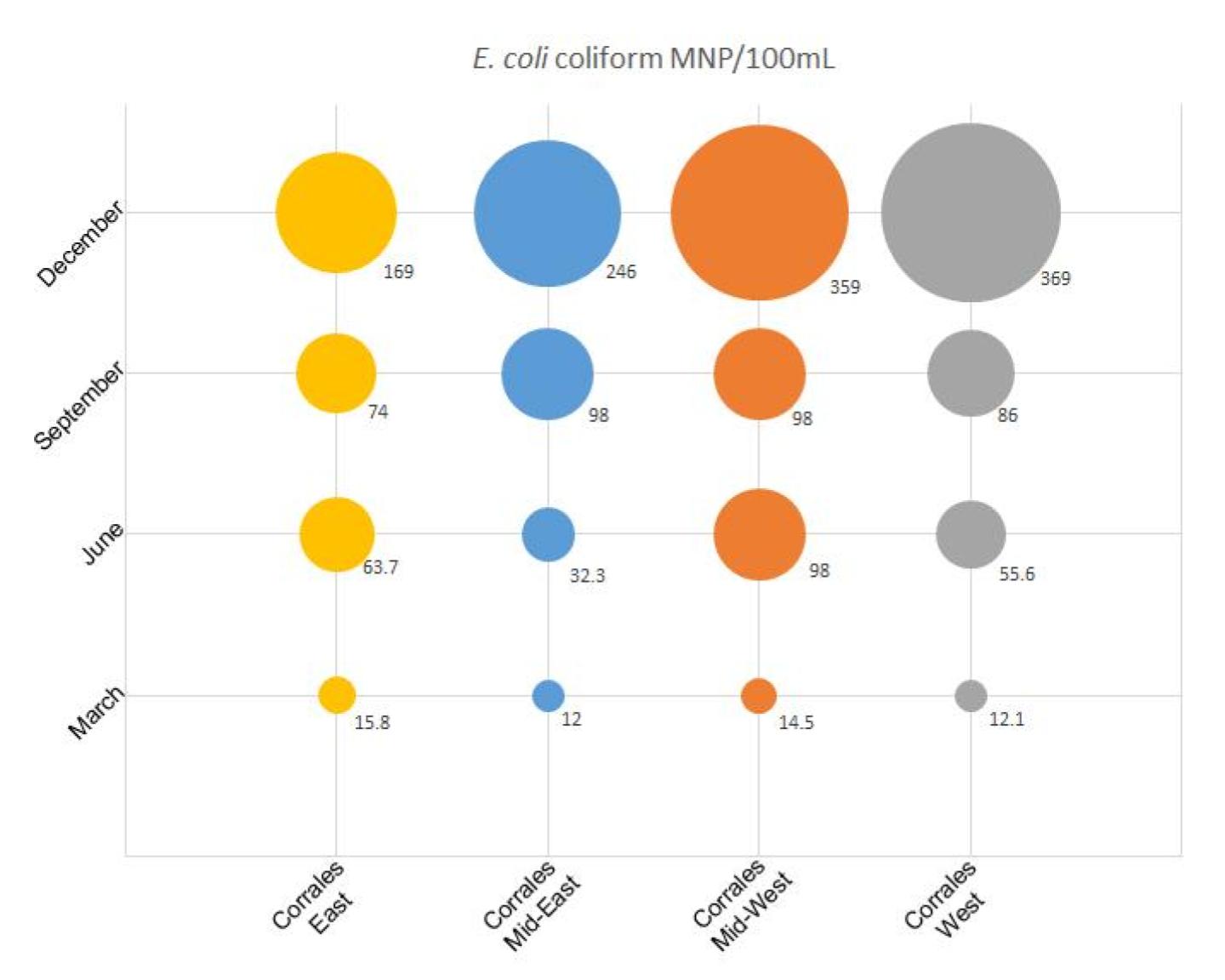
Amount of E. coli in the Rio Grande in Corrales, New Mexico. Water was collected from four points perpendicular to the river. Larger dots indicate higher amounts of E. coli in the river.
Tamarisk leaf beetles (TLBs) or Diorhabda spp. are a natural consumer of the invasive non-native tamarisk tree, also known as salt cedar. Tamarisk is widespread in the bosque and has dramatically altered riparian ecosystems by increasing salinity of soils, competing with other trees for water resources, and suppressing populations of native soil microbes. The beetle, like tamarisk, was introduced to North America from Europe and Asia. This beetle specializes on tamarisk trees, exclusively living on their branches and eating their foliage.
BEMP staff, volunteers, and interns record TLB data at several of our research sites from May to September, when the beetles are active and defoliation is occurring. To collect these data, designated trees are first photographed and rated for defoliation. The trees are then sampled for beetles using a sweep net. All arthropods captured in the sweep net are counted and identified, paying particular attention to TLBs and other Tamarisk consumers.
Although seasonal defoliation does not always kill tamarisk trees, it does weaken them and make them less competitive with native plant species. For example, a defoliated tree might take up less water and nutrients, leaving more for willows and cottonwoods. However, the interactions between these exotic species and the greater habitat are complex. Tamarisk trees have been shown to provide good nesting habitat for certain bird species in areas where native nesting habitat such as willows might be on the decline. By tracking TLB populations, we can determine the impact these insects have on tamarisk trees and whether management techniques are needed to control tamarisk populations.
BEMP collects temperature data at several of our sites using LogMaster Temperature Loggers. At sites where temperature is monitored, three loggers are installed: one in the tree canopy to capture air temperature, and two subsurface loggers to capture ground temperature (one under tree canopy cover and one out in the open). Data points are recorded hourly, giving us great resolution of temperature data for our sites. Once a year, BEMP staff and interns go out into the field with ladders, shovels, and a laptop to retrieve all the data and re-deploy the loggers.
This network of temperature loggers across BEMP sites and in various areas within sites helps us understand how temperatures fluctuate in different areas, how microclimates might behave, and how the canopy cover in the bosque might affect ground temperatures. With increasing aridity and heat becoming a pressing climate change impact, especially across the southwest, gathering data that can help us monitor these shifts is crucial to conservation and management of our bosque.
Phenology is the study of how organisms respond to changing seasons. For plants, these changes include budding, flowering, fruit production, leaf senescence (leaves drying and dropping), and more. Indigenous peoples, including farmers and scientists, all over the world have been tracking phenological stages for centuries to understand the best timing to plant crops, when insect pests emerge, and when to fertilize crops. Recording these changes gives us a snapshot of how ecosystems are being influenced by increasingly variable climate conditions.
During the growing season, BEMP tracks the timing of phenological stages of cottonwood trees at various sites across Albuquerque. This data is collected by our students and BEMP staff using the USA National Phenology Network's app, Nature's Notebook. On this app, observers of all ages and backgrounds can log valuable phenology data on plants and animals using a set of standardized questions. Every year, data from the same cottonwood trees are recorded weekly to guarantee that transitions between phenological stages are accurately observed.
Collecting these data allows us to make predictions about ecosystem functions because many organisms depend on the timing of phenological changes in plants. For example, cottonwood leaf beetles time their post-winter emergence to coincide with the budding of new leaves. These buds are the primary food source for this beetle, which then serves as a food source for small mammals, lizards, and birds. Phenology therefore has a great influence on ecological structure and nutrient cycling within the bosque. These data are useful to understand which species are most impacted by climate change and which species are adapting well to increasingly unpredictable climatic conditions.
Educational Resource Links

Nationwide phenological map from the National Phenology Network. This map shows the changes in plant leaf emergence over time. Darker red indicates leaves opening 20 days earlier than average and darker blue indicates leaves opening 20 days later.
After fires in the Albuquerque bosque in 2003-2004, natural resource managers began wondering what areas of the bosque posed the highest fire danger. Initially, managers cleared only dead and downed wood adjacent to river crossings where the probability of starting a fire due to human activity was higher (like someone throwing a cigarette out of their car). Eventually, they proceeded to clear the rest of the bosque for the same reason.
We used to measure the depth of duff (litterfall) and wood chips, as well as the maximum height of dead and down woody fuel at our sites. Transects were established, and dead and down stems/twigs that crossed the transect were counted for three different size classes: 0-0.25”, 0.25-1” and 1-3”. In addition, the diameter of all woody debris larger than 3” was measured and identified to species, because different types of wood have different burn intensities. Information from ten plots within each site was then entered into the FMAPlus 3, DDWoodyPC software, which calculated the fuel load in tons/acre. A digital photo was taken at the beginning of each transect looking towards the west in order to compare site compositional changes over time.
Woody debris data can provide valuable information about which areas of the bosque are more prone to start a fire. Natural resource managers can use our data to predict, reduce and/or prevent fires in the areas around the bosque.
Educational Resource Links
- Wood Litterfall in the Middle Rio Grande Bosque:
 Fuel load is broken down for each site based on the size class of the woody debris present. The most hazardous size classes are those in orange and red. Smaller classes are green and yellow, large to largest classes are characterized by tan, brown, and black. The red line indicates 12 tons/acre showing the limit above which the fuel load is considered a high risk of feeding hot fires. The sites Badger to State Land Office are located within Albuquerque.
Fuel load is broken down for each site based on the size class of the woody debris present. The most hazardous size classes are those in orange and red. Smaller classes are green and yellow, large to largest classes are characterized by tan, brown, and black. The red line indicates 12 tons/acre showing the limit above which the fuel load is considered a high risk of feeding hot fires. The sites Badger to State Land Office are located within Albuquerque."We use BEMP data in evaluating our Middle Rio Grande Restoration Projects. BEMP's vegetation and arthropod data helps give us a sense of the ecological health of a site before we begin a restoration project and during the restoration process."Ondrea Hummel, Ecologist, U.S. Army Corps of Engineers, Albuquerque District.
